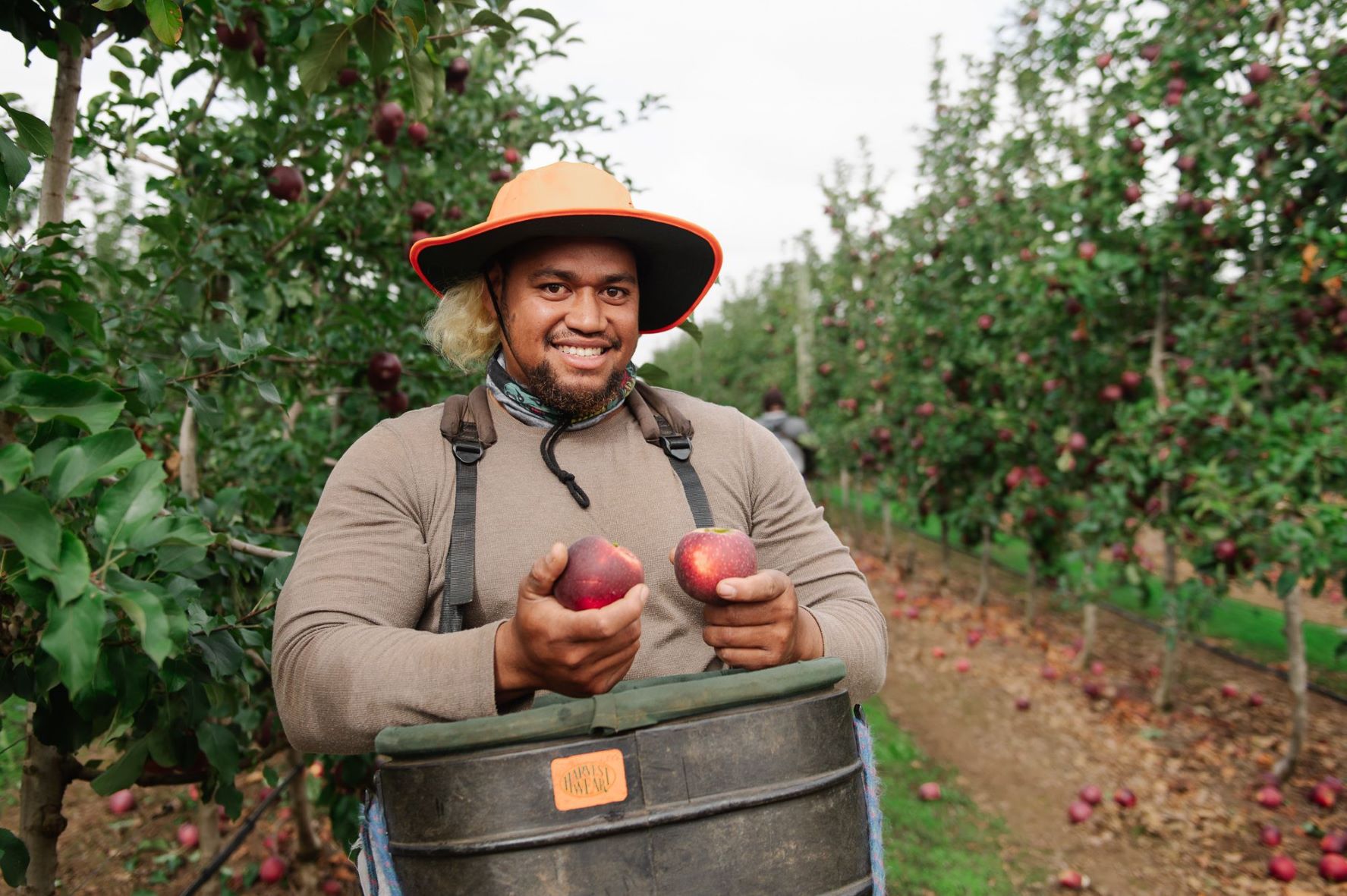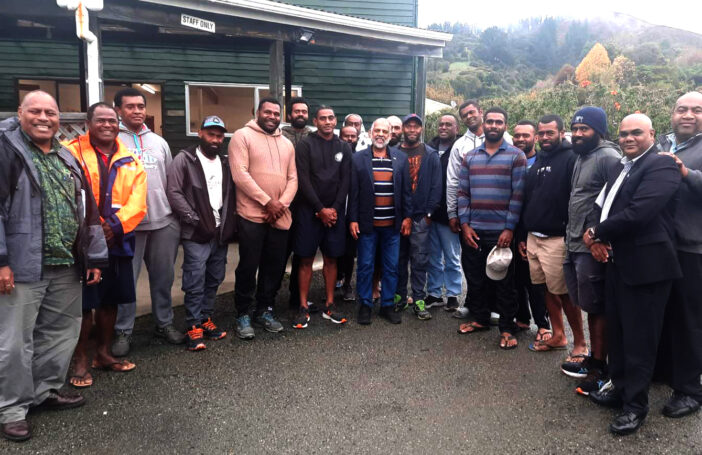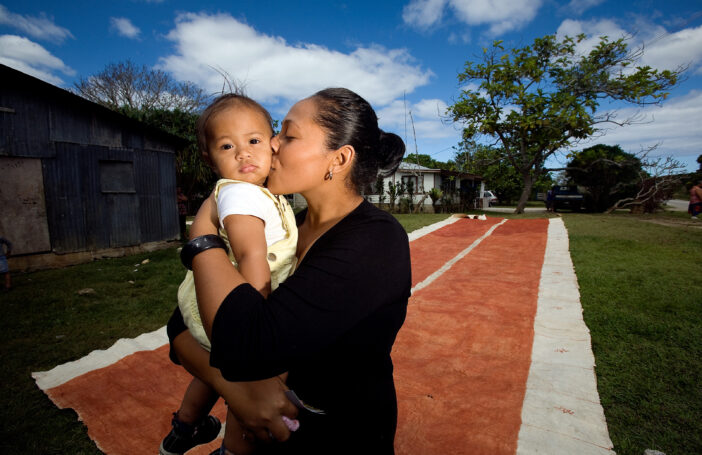The promotion of Pacific labour mobility has widespread, bipartisan support in Australia these days, but it wasn’t always so. When a seasonal worker program for the Pacific was first being considered, it met with some stiff opposition. One of the arguments against the scheme was that it would be a bandaid. “The impact on the Pacific would be negligible” argued Helen Hughes and Gaurav Sodhi in 2006.
In the end, those opposed to these schemes lost out. First New Zealand in 2006, and then Australia in 2008, introduced seasonal work schemes for Pacific Islanders, and Australia introduced the Pacific Labour Scheme (PLS) just over a decade later in 2018. Some 15 years on, what has been their impact?
We estimate that, as of the middle of 2022, there were 34,400 Pacific workers onshore in either Australia or New Zealand on one of the three Pacific temporary programs: Australia’s Seasonal Worker Programme (SWP) and the longer term PLS, and New Zealand’s Recognised Seasonal Employer (RSE) program, its SWP equivalent.
Of the 34,400 workers, a third are from Vanuatu, 22% are from Samoa and 15% are from Tonga. Another about 10% come from each of Solomon Islands and Fiji. Timor-Leste has 5%, and the remaining 5% is shared between PNG, Kiribati, Tuvalu and Nauru.

To gauge the impact of these programs, we need to divide these numbers by the working age population of the sending countries (which we define as those aged 20 to 59). Because there is a large gender imbalance in the programs, we do this separately for men and women.
The next figure shows the results by men. There are three countries where more than 10% of the male working age population is engaged on one of the three programs. In Tonga, it is almost one in five (18%), and in Samoa and Vanuatu it is 14% each. After that, the ratios are much smaller: 3% and below.

For women, the ratios are all below 3% except for Tonga. Only for the same three countries of Tonga, Vanuatu and Samoa does the ratio exceed 1%, and it almost reaches 4% in Tonga.

There is a fairly obvious conclusion from this. The impacts of the schemes are gender-specific, but the temporary schemes have been extremely impactful in the male labour markets in the three Pacific countries of Tonga, Samoa and Vanuatu, and much less so elsewhere.
Both findings are striking: the extent of the impact in the ‘big three’ sending countries, and the lack of impact in the others.
For the big three sending countries, we can compare the temporary employment gained in Australia and New Zealand with government employment at home. In all these countries, the government is the biggest employer. But in all three, about as many citizens are now working overseas on one of the three schemes as are working for government. Put crudely, for Samoa, Tonga and Vanuatu, introducing these temporary work schemes has been akin to doubling the number of government employees. That’s huge.

The Hughes-Sodhi critique clearly does, however, apply to the sending countries of PNG and Timor-Leste where participation rates are virtually zero. Of course these are much bigger countries, but, ironically, they have also sent far fewer workers. While these larger countries will never hit the migrants-to-population ratios seen in the successful and much smaller countries of Tonga, Samoa and Vanuatu, they should be able to match them at least in absolute terms of numbers of workers employed.
These very different results follow from the facts that all three schemes are demand-driven, and that employers have mainly decided to recruit from a subset of countries in the Pacific and Timor-Leste. This has been unfortunate from a development perspective, as it has meant that some of the countries that need labour mobility the most – PNG and Timor-Leste but also to a large extent Solomon Islands – have missed out on the job opportunities.
Introducing country quotas for the Pacific temporary schemes would be one response, but this greatly risks deterring employers from using these schemes at all. Instead of country quotas, both the Australian and New Zealand governments could do more to increase hiring from the underrepresented countries – and Australian employers have recently indicated their support for this. Timor-Leste isn’t even a participant in the RSE. The New Zealand scheme is capped, and a review recommended that if employers want to recruit more workers then they should have to recruit from under-represented countries. (Though not the topic of this blog, more also clearly needs to be done to improve the gender balance of the programs.)
We also need to look beyond temporary migration options. One of the strengths of the new Pacific Engagement Visa (PEV) (the Labor government’s new permanent migration scheme for the Pacific) is that it will have country quotas so that it can be directed precisely to those countries that need it. With a pro rata distribution of visas planned, PNG should be by far the biggest beneficiary of the PEV, and Timor-Leste should be the second biggest.
Returning to the Hughes-Sodhi claim, their prediction of a “negligible impact” was too pessimistic. In three Pacific countries – Tonga, Samoa and Vanuatu – labour mobility has had an impact of the sort that foreign aid could never hope to have – and all to the benefit of the Australian economy as well.
However, the Hughes-Sodhi claim does stand for a number of Pacific countries, and reminds us of the distance still to be travelled. Labour mobility has had a transformational impact in some Pacific countries over the last 15 years, but in others there is still a long way to go.
Data sources:
Pacific islands population data: United Nations, Department of Economic and Social Affairs, Population Division (2022). World Population Prospects 2022. Based on 2021 projections by age bracket and gender, population age range 20-59.
New Zealand RSE scheme: MBIE Migration Data Explorer. Data taken from peak of harvest (30/04/22), includes all workers onshore by country of origin and gender.
Australia PALM scheme:
Pacific Labour Scheme: The number of PLS visas granted by gender over the last three years, representing the maximum possible number of workers in Australia. Data provided by the Pacific Labour Facility. Includes all workers up to 30/06/22.
Seasonal Worker Programme: This data includes all current SWP visa holders, newly granted short-term PALM stream visa holders, and 408 pandemic event visa holders from Pacific island PALM countries. Sources: Department of Home Affairs Temporary Visa Holders in Australia. Includes all workers onshore as of 30/06/22. PALM short-term approvals provided by the Department of Employment and Workplace Relations.
Gender estimate for onshore SWP and 408 visa holders: calculated based on SWP % approvals by gender per country over the last three financial years (2019-20, 2020-21, 2021-22). This combined ratio was applied to total 403 SWP visa holders and 408 visa holders in country. SWP approvals data by country and gender provided by the Department of Employment and Workplace Relations.
Exclusions from workers onshore: All workers currently holding bridging visas (either waiting for a 408 visa to be approved, or having lodged a protection claim) are excluded from this analysis.
Government staff numbers: For the comparisons with government staff, census data are used for Tonga (2016) and Vanuatu (2020) and National Provident Fund data for Samoa (2021). Workers in the following sectors are assumed to be working for government: public administration, education, health, water and electricity.





Inaccurate and flawed information. While the graph showing female participation from other countries may be correct, it isn’t for PNG. PNG has been sending female workers to Australia for 4 or 5 straight years now.
My wife and her sister, Joyce and Roselyn Lawrence worked on a farm with 3 other ladies in Brisbane signed on by MADEC (employment company) in 2019.
I am not sure how it could be possible that PNG did not send any female at all under the Seasonal Labor Program till 2022 to be given a 0.0 % rating.
Hi David, thank you for your comment. Yes, Papua New Guinea has been sending women as seasonal workers for a long time, and actually has a high rate of female participation. At the time in question that this data was taken (mid-2022), over 100 women from PNG were working in Australia and New Zealand, mostly on the SWP, and that number has scaled up significantly since then. But, this graph is looking at female participation as a percentage of Papua New Guinea’s domestic population; as participation is relatively low, and PNG’s population is high, the number is low, and appears as 0.0% on the scale we are using. The actual number is that 0.004% of Papua New Guinean women are participating labour mobility. Hope this helps to clear up the data in that graph.
I am David Danga from PNG and have great internet to be part of labour’s scheme in Australia and how can I apply for this opportunity. I need your assistance to provide me or email me for the application form and necessary document for meet the labour’s requirements.
Your help will be appreciated
Thank you in advance
Hi David
For information on Australian Government labour mobility schemes please visit the website: https://www.palmscheme.gov.au/
For further information on the Pacific Engagement Visa also mentioned in this post, please see the Australian Government website: https://www.dfat.gov.au/geo/pacific/people-connections/people-connections-in-the-pacific/pacific-engagement-visa
If this argument “These very different results follow from the facts that all three schemes are demand-driven, and that employers have mainly decided to recruit from a subset of countries in the Pacific and Timor-Leste” holds true for SWP, PLS and RSE, why is the temporary migrants to Australia or New Zealand from PNG zero?
Hi Rhoda, thank you for your comment.
Some ideas for PNG to grow participation in labour mobility are detailed in a report by one of the authors of this blog, Richard Curtain, which you can read here: https://papers.ssrn.com/sol3/papers.cfm?abstract_id=3255353
Some of the barriers facing PNG are in a presentation by Natasha Turia Moka which you can find here: https://devpolicy.crawford.anu.edu.au/news-events/events/19452/8000-seasonal-workers-2025-png
The situation is different between Australia and New Zealand. There has been a large increase in workers coming from Papua New Guinea to Australia, albeit from a very low base (more than 700 now in Australia, when there were only around 40 at the end of last year). PNG has also sent a lot more workers on the longer-term (4 year) Pacific Labour Scheme; an option which isn’t available in New Zealand.
For New Zealand, there are currently 12 seasonal workers from PNG; this number has dropped from a pre-COVID peak of 135. One of the main differences is that in New Zealand, employers have to pay half the travel costs: they have to pay much more to recruit workers from places further away, which have higher costs. Some countries sending workers to New Zealand (like Kiribati and Tuvalu) have different arrangements which include longer visas and lower employer costs which take into account these countries’ remoteness. Perhaps similar arrangements for PNG could work to boost uptake.
This seems to be something the new governments in both Australia and PNG are keen to work on. There definitely needs to be a greater effort by governments to both support employers to recruit from PNG, and to work together on recruitment practices that can be mutually beneficial.
Oh yeah I am from PNG. I strongly believe the PALM SWP is a way out forward for PNG.
PNG is yet to participate in full but for the start is very much beneficial as an opportunity for exposure especially for the rural majority.
Unemployed school leavers and those pushed out of the system (education). I very much support the program going forward.
Oh yeah of course issues and challenges are but manageable.
Just proper guidelines be in place and proper screening and recruitment and that all required necessary boxes are ticked.
I think PNG should benefit big time.
And currently PNG has no Liaison Officer and I have expressed an interest through to PNG Treasury Department who through the minister Honourable Mr Ian Ling-Stucky.
I am really supporting this PALM SWP Labour Mobility and PNG should benefit big time
Thank you so much
The argument that this labour mobility scheme has benefitted the Pacific Island countries greatly needs to be assessed properly. What indices are taken to define the success of these schemes? Loss of labour force for local economic activities that keep purchasing power within the country is badly affected, social issues related to absence of partners for lengthy duration, domestic violence, labour abuse in recipient countries, lack of transparency on actual income and net benefit flows etc.
What is needed is a regionally based study on the benefits of regional labour schemes and a pathway forward that would be beneficial for sending and recipient countries.
For too long we have been led to believe that economic benefits outweigh the social and environment costs. Let’s be more discerning after more than a decade of unregulated access to a labour market in the Pacific region.
Thank you for your response to our blog on the employment impact of the Pacific labour mobility programs. As we state in the blog, we are presenting evidence ‘to gauge the impact of these programs’. We do this by comparing the number of workers employed under these programs in both Australia and New Zealand with three benchmarks. These are the number of males and females of working age population of ten sending countries and the number of workers in government employment in three major sending countries: Vanuatu, Samoa and Tonga. We conclude that these Pacific labour mobility programs on these three measures in terms of employment have had a major impact.
Our purpose was not to look at other measures of success. One obvious measure is the large number of people on this programs, showing by their participation that they want to take up these jobs. This vote of confidence is reinforced by the high return rate (74 per cent) of workers on seasonal work programs.
Other measures of benefits have been covered in independent surveys, most recently in 2018 by the World Bank in its report ‘Maximizing the Development Impacts from Temporary Migration’. The current Pacific Labour Mobility Survey, which is being conducted by Devpolicy at ANU and the World Bank, is assessing the benefits and impact of workers in the SWP, RSE and the PLS. These net benefits including income gains, welfare and other social outcomes are being measured by comparing migrants with a control group of non-migrants, their households and communities in Tonga, Kiribati and Vanuatu.
Preliminary results based on data collected November 2021 to January 2022 showed that Tongan migrants still achieve large earnings gains from working in Australia or New Zealand. Gains appear larger for the SWP than the PLS, and for migrants to Australia compared with New Zealand. Also remittance levels remain an important source of income for sending households, covering mostly basic expenses and education.
Yes, more needs to be done to report on the nature and extent of any harmful effects. Two recent Devpolicy blogs deal with the social effects of Pacific labour mobility: Matt Withers on Pacific migrant workers and the social costs of family separation (https://devpolicy.org/pacific-migrant-workers-and-family-separation-20220816/) and Charlotte Bedford, Richard Bedford and Rena Tekanene on i-Kiribati female seasonal workers in New Zealand: lived experiences (https://devpolicy.org/i-kiribati-female-seasonal-workers-in-new-zealand-lived-experiences-20210901/). My three forthcoming blogs on brain drain and related matters also address other side effects of increased overseas labour mobility.